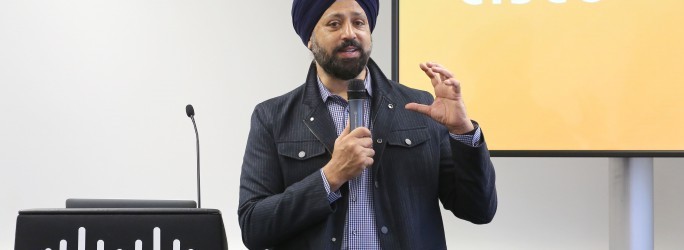Cisco: Digital transformation will usher in analytics-driven ‘fourth era of IT’

Focus: Cisco has spent big to diversfiy from networking and new CTO Zorawar Biri Singh says it is ideally placed to deliver analytics, IoT-driven business transformation
Even for a company that has spent the past few years in transition, the past few months have seen a lot of change at Cisco.
As part of the ongoing diversification away from networks, long-serving CEO John Chambers has been replaced by Chuck Robbins, a new executive team has been appointed, and the firm has made a number of significant purchases – most notably OpenDNS, Lancope and Jasper – to strengthen its portfolio.
The 13,000 attendees at Cisco Live in Berlin this week were told how this combination of network, cloud, security, software and analytical capabilities can enable “digitisation” – the company’s replacement buzzword for the Internet of Everything (IoE).
It says true business digitisation involves the transformation of business processes, worker efficiency and customer experience, to boost revenues and efficiency.
Convincing potential customers of this message appears to be critical for Cisco’s future prospects. Total revenues continue to rise, but areas like cloud, security, analytics and collaboration need to continue to perform as the fortunes of its switching, routing and data centre divisions fluctuate.
 Of course, this vindicates the decision to spend big and diversify to ensure Cisco is responsible for connecting the billions of things that will soon come online – something Robbins reiterated earlier this month.
Of course, this vindicates the decision to spend big and diversify to ensure Cisco is responsible for connecting the billions of things that will soon come online – something Robbins reiterated earlier this month.
For new CTO Zorawar Biri Singh, digitisation is about ushering in the “fourth era of IT”, a period which succeeds the “mainframe”, “PC and web”, and “cloud and mobile” eras, characterised by automation and data analytics.
“Digitisation has been spoken about for the past five years in some shape or form,” he said at Cisco Live. “Part of my role is taking the digitisation effort and strategic commitment that John [Chambers] laid out a few years ago and tying that to our portfolio and deployment strategy.
“I think people generally understand data centres and our network and are very interested in analytics, which is something I’m passionate about it. We had big announcements in security and we’re making big strides in collaboration.”
 At the heart of this vision is the network – Cisco’s bread and butter – and the Internet of Things (IoT) – the key enabling technology.
At the heart of this vision is the network – Cisco’s bread and butter – and the Internet of Things (IoT) – the key enabling technology.
“I think Cisco’s future is about connecting billions of people to billions of machines,” said Singh. “I think we see IoT as an evolution of everything we’ve done in our networking. Cisco is not just going to participate in the networking of devices – I think we have the responsibility, not permission, to do that.”
“Having an IoT strategy at Cisco has been vital. What we’re doing now is evolving that view to have a full IoT stack.”
This IoT strategy would be boosted by the acquisition of Jasper, he said, providing Cisco with a “mature” platform for cellular, device management and analytical capabilities, but he was less concerned about which standard was used to power connected devices.
When asked about his views on the various competing standards, such as Wi-Fi, Bluetooth and SIGFOX, and the inability to finalise the Narrowband-IoT (Nb-IoT) cellular specification, Singh said connectivity would vary according to the device and the customer.
“It’s about the economics of the connectivity,” he replied, noting that cellular might be more appropriate for a connected car than a sensor in some cases. “It’s also an economic thing for service providers and how they refresh their networks. We have to design an IoT network for the future that’s multi-protocol.”
 Digitisation will also see the emergence of data-driven applications as the IT industry shifts towards real time analytics,
Digitisation will also see the emergence of data-driven applications as the IT industry shifts towards real time analytics,
Analytics is central to Cisco’s vision. Real time analysis and data driven applications are being enabled by a move away from “traditional IT” to stacks comprising bare metal infrastructure, light operating systems and cloud-based management software, Singh said, arguing this shift in consumption presented another opportunity for the company.
“We’re building stacks for the next generation of data analytics,” he said, citing Cisco’s participation and investment in container technologies as evidence. “Everyone’s going to need stacks to handle this type of data.”
But there was also an admission that digitisation will bring new risks. Cisco says security is its customers’ “biggest problem” and that the addition of new devices to the network will make the problem worse by offering more attack surfaces.
Compounding this, it argues, is that security products are becoming too complex, making it difficult for companies to effectively protect themselves. Cisco released a number of new services and appliances this week in a bid to combat this and boasted of its own security credentials.
“Cisco is actually the largest security software company. We have a huge portfolio,” said David Goeckeler, general manager of Cisco’s Security Business Group. “We’re continuing to expand that. We’ve spent billions of dollars on mergers and acquisitions and hundreds of millions on research and development.
“When we talk about digitisation at Cisco, security is at the heart of it.”